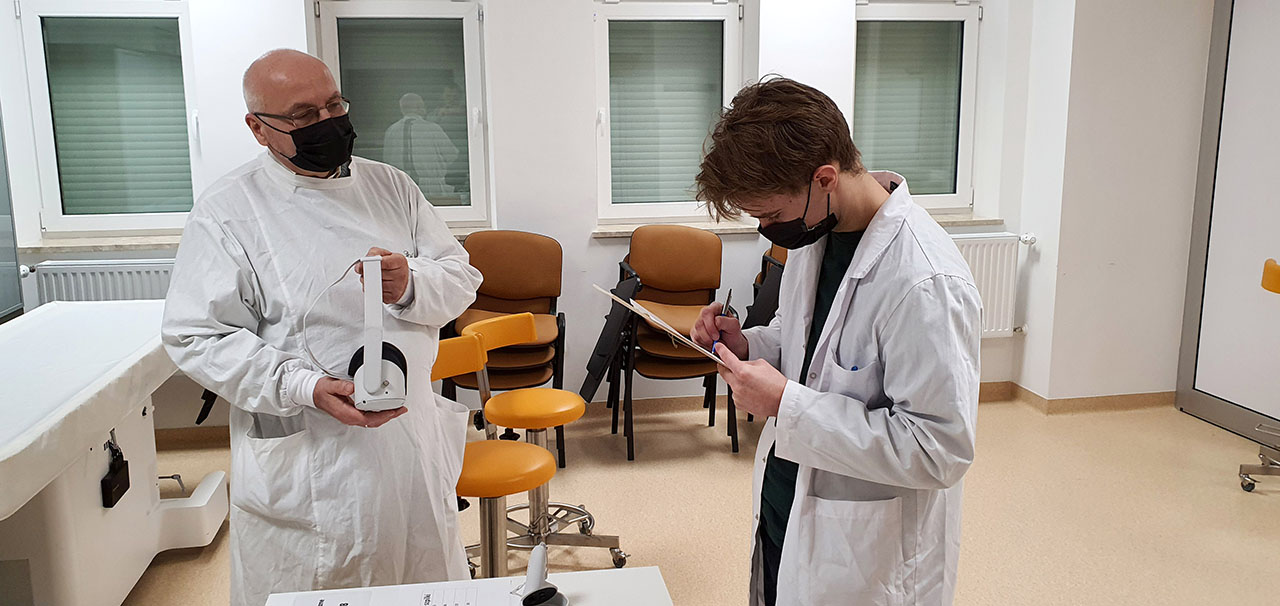Teach, Train and Test. Next-Gen Medical Education in Virtual Reality
“I Wished Medical Virtual Reality Existed When I Was a Student!”
Medicalholodeck® is not only great to teach gross anatomy, real patient cases, and any other medical-related field in virtual classrooms but also to examine students' knowledge in VR, as now done at the Collegium Anatomicum of Radom University in Poland.
The use of Virtual Reality (VR) in health professions education has increased dramatically in recent years, yet there is limited evidence of its impact on educational outcomes. The purpose of the study was to assess the impact of VR anatomy instruction on the ultrasound competency of novice learners participating in a ultrasonography workshop.
The newly established
Collegium Anatomicum Radom
under Professor Dr. Lukasz Wysienski started using medical virtual reality in autumn 2021. From the beginning, the faculty was using the complete Medicalholodeck bundle to connect classes of students in virtual reality.
Being also a surgeon in the city of Warsaw, Professor Wysienski taught students remotely in VR. This allowed him to stay in Warsaw, while teaching anatomy and real patient cases in immersive 3D in the faculty of Radom, 100 km away.

Setting up Medicalholodeck was fast and easy. The faculty ordered 20 light-weight Meta Quest 2 headsets and the Medicalholodeck software, including its Remote Rendering option. Thanks to Remote Rendering technology, computers were not necessary for high-performance use. This saved the faculty a lot of time, money, and space.
After teaching human anatomy for one semester in virtual reality, Professor Wysienski went one step further and also used
Medical Imaging XR
during an objective structured clinical examination (OSCE). Cloud rendering technology was extremely helpful in this case too. Professor Wysienski’s team just put two Quest VR headsets on a table, without installing any computers, sensors, or cables. Only an extension cord to support the limited battery power of the Quest VR headsets and a normal speed wifi connection were necessary.

The Professor uploaded CT DICOM from a human brain to Medicalholodeck and marked several structures in VR, such as the internal carotid artery and the left vertebral artery. The students then had to name these correctly. In less than 6 hours, over 180 students were passing the exam in virtual reality without any problem.
Professor Wysienski is very excited about the outcome of using Medicalholodeck, for both teaching and exam. “The students are learning gross anatomy much faster than before. It was amazing to see how fast the students were able to use the Medicalholodeck apps and how fascinated they were with the provided anatomy data.” “I wished medical virtual reality existed when I was a student back in the nineties!” he added with a smile.
For young people the use of virtual reality and computer games is normal, and therefore it is not surprising that they immediately understood how to use Medicalholodeck. Discussing with students after the test, they agreed that their learning curve was much steeper compared to books, and they appreciated the use of time-saving technology in their very busy life.

Both teachers and students were thrilled by the excellent quality of the 3D anatomy data provided in Dissection Master XR. The super high resolution and the complete annotations fully met their expectations. Professor Wysienski is convinced to have set a new level of state-of-the-art medical teaching in Poland.
He also sees huge future potential for medical teaching and professionals alike. As a trained and active Otolaryngologist himself, he intuitively understood the advantages of handling 3D data in immersive virtual reality space. He thinks that medical virtual reality is going to transform the way medicine is taught in the years to come.
Also, the feedback from this first group of students was very positive. They appreciated the modern approach and the time saved by studying in virtual reality. This first semester was such a success that the use of Medicalholodeck will be expanded next semester.
For more information, contact
info@medicalholodeck.com
February 2022


